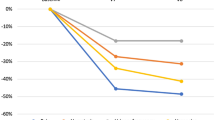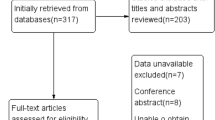Abstract
Objective
To verify the efficacy and safety of intravesical instillation of pirarubicin combined with hyaluronic acid after TURBT in non-muscle invasive bladder cancer patients.
Methods
We conducted a prospective study recruiting 127 eligible patients from 2008 to 2010. Patients were randomly assigned to Group A (pirarubicin combined with hyaluronic acid) and Group B (pirarubicin alone). Patients’ demographics, treatment efficacy on recurrence, visual analog scale score, and postoperative complications were evaluated and analyzed during observation.
Results
After the first month of intravesical chemotherapy, a perceptible relief of pelvic pain and urinary symptoms was detectable in Group A when compared with Group B (Fig. 2; P = 0.04). From objective analysis, the clinicians observed a consistent better improvement in Group A than in Group B on clinical conditions (P = 0.02). Frequency, urgency, and odynuria are relieved effectively in Group A (21/64 32.9 %) and in Group B (41/63 65.1 %), with significant difference observed (P = 0.001). No statistical evidence of benefit was observed in terms of recurrence. No obvious hyaluronic acid-related adverse event was observed.
Conclusions
As compared to intravesical instillation of pirarubicin alone, the administration of pirarubicin combined with HA for prevention from postoperative recurrence was satisfactory and safe. The relief of pelvic pain and urinary symptoms is more rapid and more durable.


Similar content being viewed by others
References
American Cancer Society (2012) Cancer facts and figures 2012. American Cancer Society, Atlanta
Pashos CL, Botteman MF, Laskin BL, Redaelli A (2002) Bladder cancer. Cancer Pract 10:311–322
Shelley MD, Wilt TJ, Court J, Coles B, Kynaston H, Mason MD (2004) Intravesical bacillus Calmette-Guerin is superior to mitomycin C in reducing tumour recurrence in high-risk superficial bladder cancer: a meta-analysis of randomized trials. BJU Int 93:485
Avritscher EBC, Cooksley CD, Grossman HB et al (2006) Clinical model of lifetime cost of treating bladder cancer and associated complications. Urology 68:549–553
Sylvester RJ, Oosterlinck W, van der Meijden AP (2004) A single immediate postoperative instillation of chemotherapy decreases the risk of recurrence in patients with stage Ta T1 bladder cancer: a metaanalysis of published results of randomized clinical trials. J Urol 171(6):2186–2190
Babjuk M, Oosterlinck W, Sylvester R, Kaasinen E, Bohle A, Palou-Redorta J (2011) EAU guidelines on non-muscle-invasive urothelial carcinoma of the bladder, the 2011 update. Eur Urol 59:997–1008
Hall MC, Chang SS, Dalbagni G et al (2007) Guideline for the management of nonmuscle invasive bladder cancer (stages Ta, T1, and Tis): 2007 Update. J Urol 178:2314–2330
Huland H, Kloppel G, Feddersen I, Otto U, Brachmann W, Hubmann H et al (1990) Comparison of different schedules of cytostatic intravesical instillations in patients with superficial bladder carcinoma: final evaluation of a prospective multicenter study with 419 patients. J Urol 144:68
Eijsten A, Knonagel H, Hotz E, Brutsch HP, Hauri D (1990) Reduced bladder capacity in patients receiving intravesical chemoprophylaxis with mitomycin C. Br J Urol 66:386
Ots PMS, Carrizosa CL, Rodríguez A, de Dios Sáez J, Delgado JM, de Miguel MM, Vidal M (2009) Vesical instillations of hyaluronic acid to reduce the acute vesical toxicity caused by high-dose brachytherapy do not affect the survival: a five-year follow-up study. Clin Transl Oncol 11(12):828–834
Siegel R, Naishadham D, Jemal A (2012) Cancer statistics, 2012. CA Cancer J Clin 62:10–29
Mostofi FK, Sobin LH, Torloni H (1973) Histological typing of urinary bladder tumors. International histological classification of tumors, vol 10. World Health Organization, Geneva, pp 15–17
Rubben H, Lutzeyer H, Fischer N et al (1988) Natural history and treatment of low and high risk superficial bladder tumors. J Urol 139:283–285
Schilling JD, Mulvey MA, Hultgren SJ (2001) Dynamic interactions between host and pathogen during acute urinary tract infections. Urology 57:56–61
Reid G (1999) Current scientific understanding of urinary tract infections in women: an overview. World J Urol 17:336–338
Gupta K, Stamm WE (1999) Pathogenesis and management of recurrent urinary tract infections in women. World J Urol 17:415–420
Poggi MM, Johnstone PAS, Conner RJ (2000) Glycosaminoglycan content of human bladders: a method of analysis using cold cup biopsies. Urol Oncol 5:234–237
Morales A, Emerson L, Nickel JC (1997) Intravesical hyaluronic acid in the treatment of refractory interstitial cystitis. Urology 49:111–113
Parsons CL (1997) Epithelial coating techniques in the treatment of interstitial cystitis. Urology 49:100–104
Daha LK, Riedl CR, Hohlbrugger G, Knoll M, Engelhardt PF, Pflüger H (2003) Comparative assessment of maximal bladder capacity, 0.9% NaCl versus 0.2 M KCl, for diagnosis of interstitial cystitis: prospective controlled study. J Urol 170:807–809
Schiavenato M, Craig KD (2010) Pain assessment as a social transaction: beyond the “gold standard”. Clin J Pain 26(8):667–676
Topazio L, Miano R, Maurelli V, Gaziev G, Gacci M, Iacovelli V, Finazzi-Agrò E (2014) Could hyaluronic acid (HA) reduce Bacillus Calmette-Guérin (BCG) local side effects? Results of a pilot study. BMC Urol 13(14):64. doi:10.1186/1471-2490-14-64
Li NC, Ye ZQ, Na YQ, CUA THP Immediate Instillations Study Group (2013) Efficacy of immediate instillation combined with regular instillations of pirarubicin for Ta and T1 transitional cell bladder cancer after transurethral resection: a prospective, randomized, multicenter study. Chin Med J (Engl) 126(15):2805–2809
Ito A, Shintaku I, Satoh M et al (2013) Prospective randomized phase II trial of a single early intravesical instillation of pirarubicin (THP) in the prevention of bladder recurrence after nephroureterectomy for upper urinary tract urothelial carcinoma: the THP Monotherapy Study Group Trial. J Clin Oncol 31(11):1422–1427. doi:10.1200/JCO.2012.45.2128 (Epub 2013 Mar 4)
Conflict of interest
All authors state that they have no conflict of interest.
Author information
Authors and Affiliations
Corresponding author
Rights and permissions
About this article
Cite this article
Huang, W., Wang, F., Wu, C. et al. Efficacy and safety of pirarubicin combined with hyaluronic acid for non-muscle invasive bladder cancer after transurethral resection: a prospective, randomized study. Int Urol Nephrol 47, 631–636 (2015). https://doi.org/10.1007/s11255-015-0940-1
Received:
Accepted:
Published:
Issue Date:
DOI: https://doi.org/10.1007/s11255-015-0940-1




